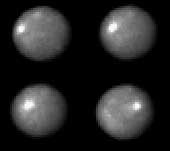|
COMETS EARTH JUPITER KUIPER BELT MARS MERCURY METEORITES NEPTUNE OORT CLOUD PLUTO SATURN SOLAR SYSTEM SPACE SUN URANUS VENUS ORDER PRINTS
PHOTO CATEGORIES SCIENCEVIEWS AMERICAN INDIAN AMPHIBIANS BIRDS BUGS FINE ART FOSSILS THE ISLANDS HISTORICAL PHOTOS MAMMALS OTHER PARKS PLANTS RELIGIOUS REPTILES SCIENCEVIEWS PRINTS
|
Related Documents
Download Options
NASA's Hubble Space Telescope took these images of the asteroid 1 Ceres over a 2-hour and 20-minute span, the time it takes the Texas-sized object to complete one quarter of a rotation. One day on Ceres lasts 9 hours. Hubble snapped 267 images of Ceres as it watched the asteroid make more than one rotation. By observing the asteroid during a full rotation, astronomers confirmed that Ceres has a nearly round body like Earth's. Ceres' shape suggests that its interior is layered like those of terrestrial planets such as Earth. Ceres may have a rocky inner core, an icy mantle, and a thin, dusty outer crust inferred from its density and rotation rate. The bright spot that appears in each image is a mystery. It is brighter than its surroundings. Yet it is still very dark, reflecting only a small portion of the sunlight that shines on it. Ceres is approximately 580 miles (930 kilometers) across and is the largest known asteroid. It resides with tens of thousands of other asteroids in a region between the orbits of Mars and Jupiter called the main asteroid belt. Besides being the largest asteroid, Ceres also was the first to be discovered, in 1801. Astronomers enhanced the contrast in these images to bring out important features on Ceres' surface. The observations were made in visible and in ultraviolet light. Hubble took the snapshots between December 2003 and January 2004. Credit: NASA, ESA, J. Parker (Southwest Research Institute), P. Thomas (Cornell University), and L. McFadden (University of Maryland, College Park) |
